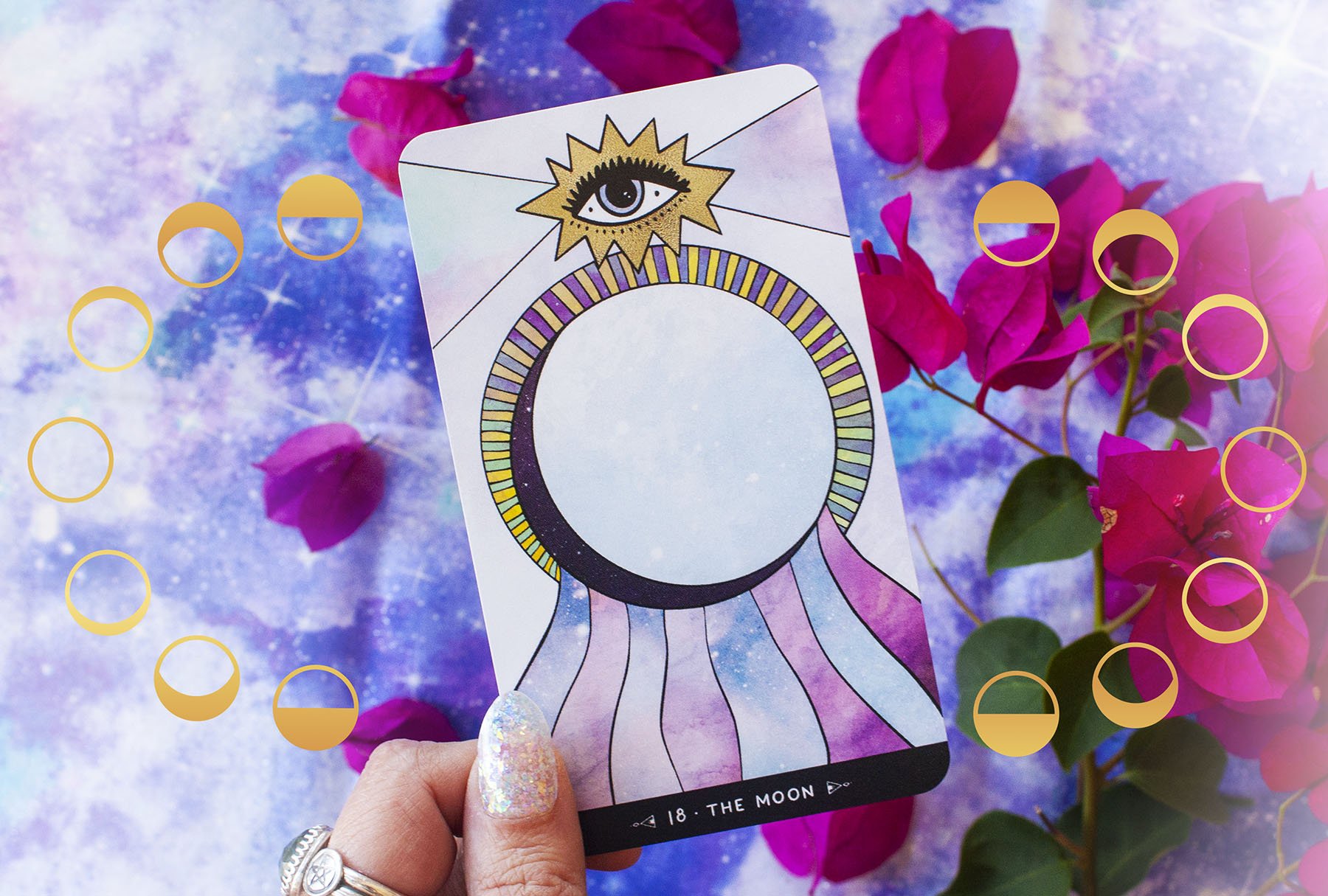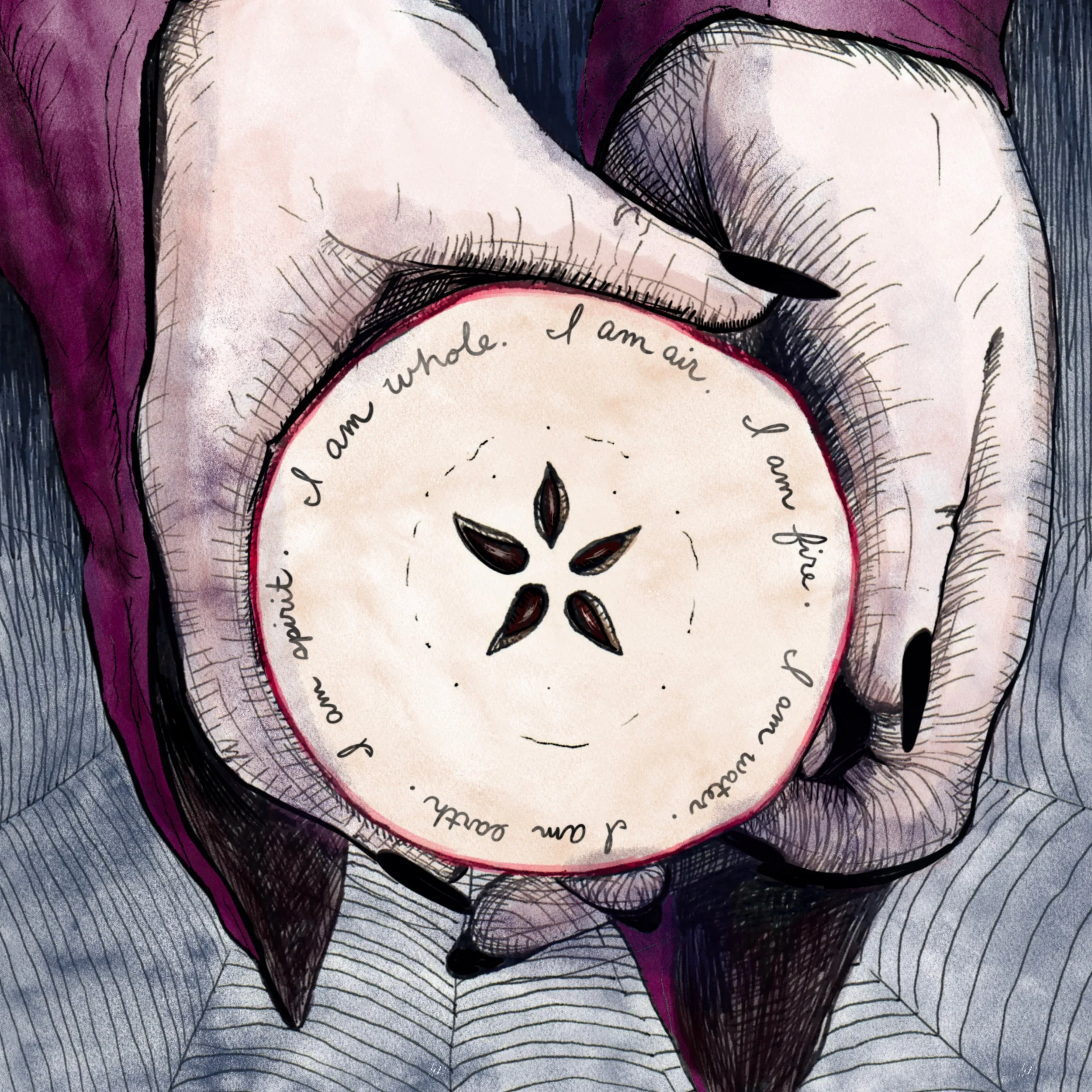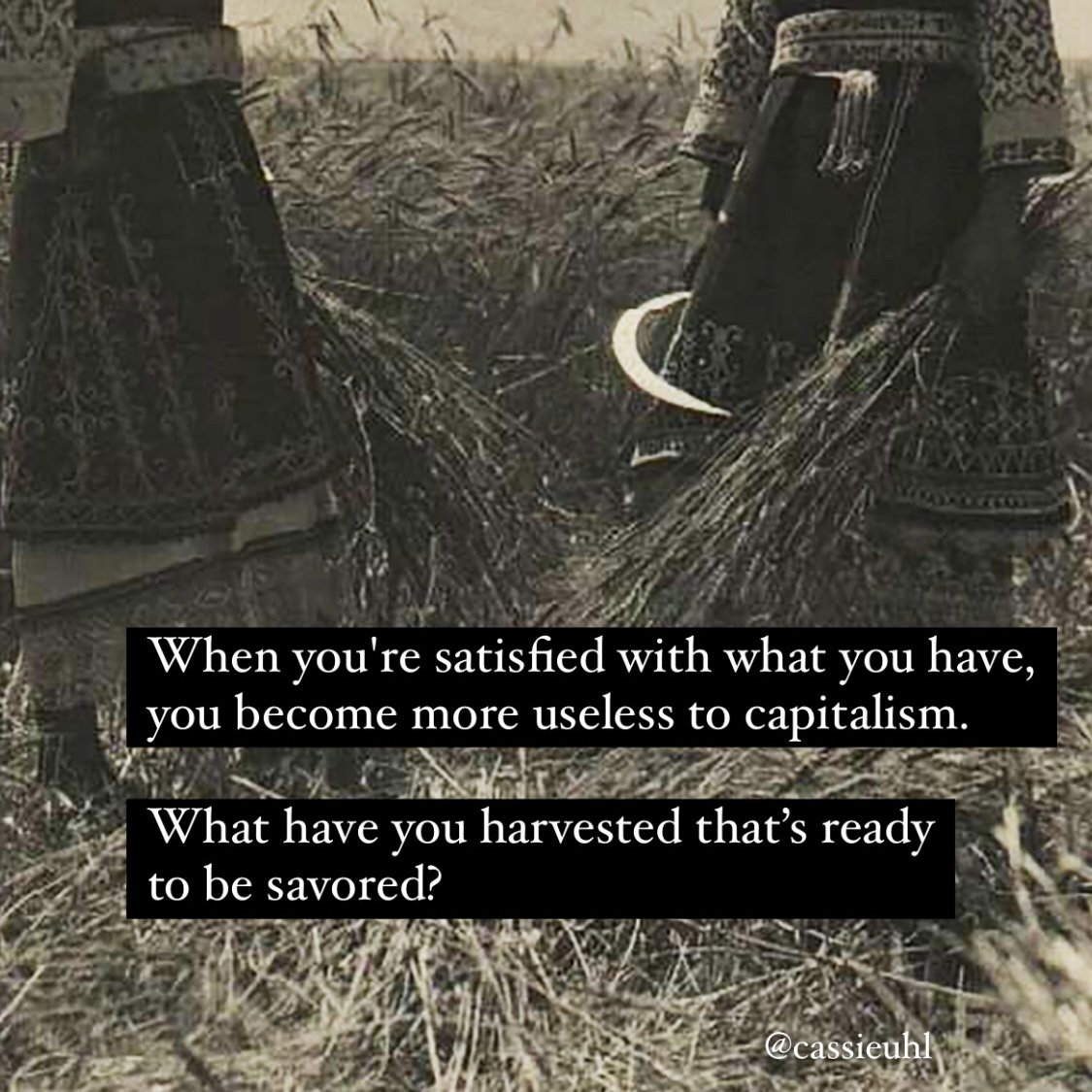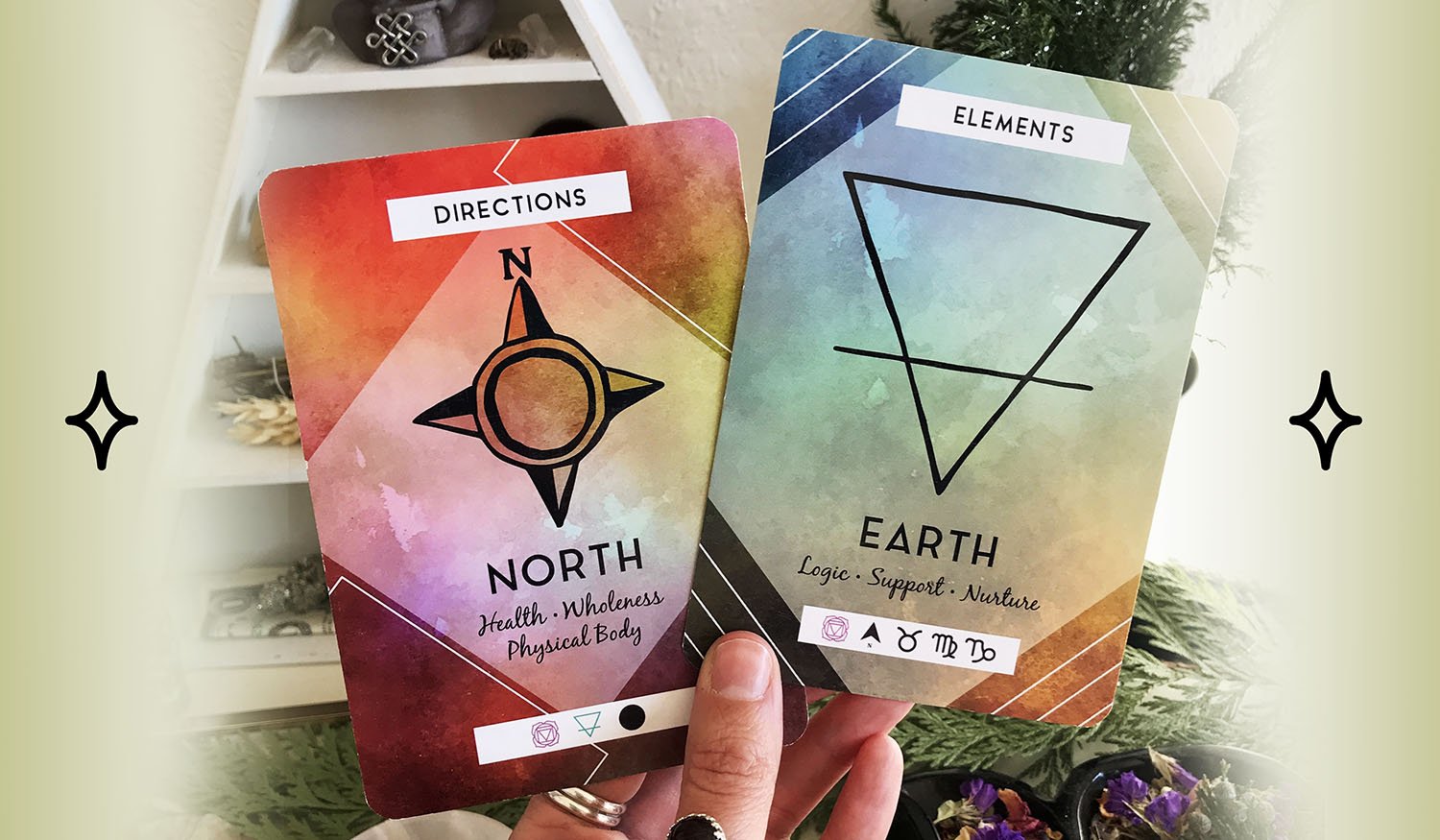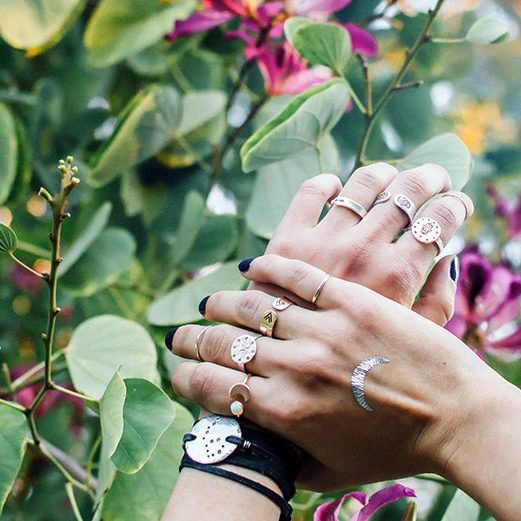Why We Vigil & The Oak and Holly King
Vigil means to stay awake and keep watch in the dark. In a season dominated by darkness, the vigil invites presence. While often touted as a passive, restful season, being awake to what’s going on in the dark requires awareness; it’s also where you’ll find the richest compost.
As winter steals the sunlight, the land reacts by going silent, hibernating, and sometimes dying, reminding us to peel back hurried layers of mundane to-dos and sink deeper into the darkness. Vigil means to stay awake and keep watch in the dark. In a season dominated by darkness, the vigil invites presence. While often touted as a passive, restful season, being awake to what’s going on in the dark requires awareness; it’s also where you’ll find the richest compost.
With a candle in hand, do you see what’s ready to die within you this season, or are you prepared to sit with what’s dying in your family, community, or the world? In a primarily death-phobic society, the vigil asks us to honor the wisdom of death and dying.
A beautiful example of the need for balance in our understanding of birth and death comes through the story of the Oak King and the Holly King, two mythical land figures embodying dark and light. While no one knows the exact origins of the Oak and the Holly king, versions of their story can be found throughout Ireland, Wales, and England.
I’ll share my version of this story, adapted from several versions I’ve heard and read. I’ll also share more about vigils, their importance, and ways to reclaim this sacred practice of being awake in the face of death.
The Oak King and The Holly King
Long ago and still to this day, there were two brothers, the Oak King and the Holly King. These brothers ruled over the lands now called Ireland, Wales, and England. The Oak King brought light, warmth, growth, fertility, and abundance. He was sometimes called the green man of the forest. On the other hand, the Holly King brought darkness, cold, rest, decay, and death.
“The Oak King” and “The Holly King” by Anne Stokes
The brothers often battled, bringing light, darkness, warmth, and cold throughout the land. Over time, the people began to favor the Oak King and preferred the warm sunlight and the abundance he brought to the land and their crops. As favor grew for the Oak King, he became stronger with the help of the people, driving the Holly King farther and farther north.
Endless Summer
Eventually, the Oak King reigned throughout the land and brought what seemed like an endless summer. The people were delighted and relished the warmth and abundance of their crops. After a long time, however, they noticed their crops were not as bountiful, and the blooms of the flowers were not as bright as they once were. Not only was the land growing tired, but the people, too, were growing tired of constantly harvesting. Unsurprisingly, the Oak King himself was beginning to tire as well.
Tucked far away to the north, the Holly King noticed that his brother and the people were growing tired. He knew it was time to make his return. After over a year, on the day of the year when the sun shone the longest, the Holly King returned to the south to battle his brother. While the Oak King did battle, it was short-lived because he was so tired.
Winter Returns
The Oak King retreated into the forest to rest while the Holly King took over again. Quickly, a cold and dark winter covered the land. The land was quiet again, and the people were grateful to go into their houses around the fire to rest and tell stories. The plants were grateful to die back and return to the land to compost for another growing season.
After some months, as the nights grew longer and longer, the Oak King began to stir after his long rest. On the longest night of the year, the Oak King returned full of strength to battle his brother again. The battle took much longer, with the Oak King and the Holly King at full strength. They fought day in and day out, the days slowly getting lighter until eventually spring returned, and the Holly King began retreating north to rest again.
The Need for Balance
From then on, the brothers continued their annual battles to protect the well-being of the earth and all her creatures. The people and the brothers now understand the importance of the balance of light and dark and that both are needed to support the earth and its seasons. Still, to this day, we can celebrate the brothers at the height of their power: the Oak King on the summer solstice and the Holly King on the winter solstice, and the gifts they bring by honoring their true nature. So it is.
Why We Vigil
The story of the Oak King and the Holly King expresses the need for balance between light and dark, warmth and cold, expression and receptivity, and birth and death. None of these themes are good or bad; as the story teaches, they are all necessary to life. In our hyper-productive capitalist society, we tend to focus on the light, expression, and birth parts. So often, hiding death and dying away to focus on more, bigger, and better. The Holly King teaches us that death is necessary for life, and the holly plant that remains green-leafed throughout winter reminds us to be present with what’s dying.
With our quickly warming climate, like the people in the story, perhaps we’re also headed for an endless summer. While I don’t believe sitting vigil is the cure to human-made global warming, I do think death has much to teach us, and the best way to learn about death is to sit with it. The word vigil comes from the Latin word “awake.” Vigil goes beyond understanding that there is a need for death; it is an opportunity to honor the wisdom of death by remaining awake and aware of it.
The vigil honors the inevitability, presence, and importance of death. Sitting vigil helps us remember our seasonality, humanity, impermanence, and humility. The vigil is not the time to shame and blame based on the past or dream of the future; it calls you into the present moment. When you enter into the vigil, the time for resuscitation has ended. It is now time to surrender to the process of dying. We do not vigil to tell what’s dying how to die; we vigil to honor the death process and the magic that the Holly King brings with winter. We vigil to lean in and trust the Great Mystery together.
Similar to birthing, our bodies know how to die. Cycles of death and rebirth happen in your body every day. Cells all over your body die. We bleed, sleep, shed, and change. In these bodies, we are cyclical and ever-changing beings. Dying, just like living, is in our nature.
Welcoming the Vigil
What’s dying in your body, mind, and soul? What’s dying in your home, community, and the world? How would you live your life if you trusted death? Death carries innate wisdom, and when you avoid it, you cut yourself off from the remembered wisdom held within your blood and bones. How can you reclaim this innate wisdom? Remaining awake and present to death within and around you is one way to remember. While deciding to sit in vigil is a massive privilege, its importance remains.
Winter Solstice vigil.
Vigils need not be relegated to the dying person. Even if you don’t want to admit it, you are surrounded by death every day. Opening yourself up to the practice of the vigil opens you to death processes already occurring within and around you. All you have to do is decide to be present with them, which is a practice.
Sitting vigil was never intended to be done alone or long-term. Vigil requires a honed ability to be present with what is, even when uncomfortable. While it might appear passive, it requires self-awareness, emotional regulation, and discernment. Like birth, it is a communal act that happens in shifts. You may visit the depths for some time, but eventually, you’ll need to pass the baton to tend within, knowing others will keep watch.
Here are some simple ways to weave vigil into your practice.
Ways to vigil
Vigil with winter: Sit outside in winter amidst dying plants, perhaps a specific plant you already have a relationship with, and listen and notice for as long as you want or can. Notice what’s happening to the plant(s) in their dying process. Note physical and energetic changes.
Hold a candlelight vigil to be with what’s dying in the world: Light a candle at night, in your home, or outside, and set aside time to contemplate something dying in the world. As I said, there’s no shortage of death around us. What deaths are weighing heavy on your heart? Can you be present with them without trying to change them or apply a narrative to the death? What do you notice physically and energetically? This could be done solo or in a small group.
Hold a candlelight vigil for yourself: Light a candle at night, in your home, or outside, and set aside time to contemplate something dying within you. You are a cyclical being, constantly changing. Whether it’s your body, beliefs, or how you operate, cycles of death and rebirth are always present. Notice your personal seasons and deaths occurring within you, not to change them but to be present with them.
Attend a vigil: Communal vigils occur for all kinds of reasons. See if you can find one in your community to attend. I also hold occasional virtual vigils called Living Vigil. Click here to see if one is on the books.
Reclaiming the practice of the vigil can help you reclaim a part of your innate humanness. Like the holly plant that remains alive throughout winter, you, too, can meet death with honor and reverence. As winter works its magic, light your candles and remember there’s wisdom in the dark.
Rituals to Embody the Harvest Season
Let's go beyond "grateful" decor or compulsory gratitude lists this harvest season, shall we? In a world infiltrated with attention economics, it can feel difficult or even unsafe to savor the fruits of your labor, but the truth is, we really need to (I’ll share why later.) Whether it’s your garden or a new endeavor, each harvest season grants you a sacred pause to evaluate what needs to go into the compost and what you want to harvest. But, with harvest comes responsibility. If the harvest goes untended or forgotten, it will undoubtedly rot.
Gleaners, by James Tissot. Public domain.
Let's go beyond "grateful" decor or compulsory gratitude lists this harvest season, shall we? In a world infiltrated with attention economics, it can feel difficult or even unsafe to savor the fruits of your labor, but the truth is, we really need to (I’ll share why later.) Whether it’s your garden or a new endeavor, each harvest season grants you a sacred pause to evaluate what goes into the compost and what you want to harvest. But, with harvest comes responsibility. If the harvest goes untended or forgotten, it will undoubtedly rot.
In this post, you'll learn what the harvest season means and its importance. You'll also find a card spread and ritual to help you embody what you're harvesting this season that goes beyond a basic gratitude list.
What is the harvest season?
For many witches and pagans, the Autumnal Equinox sits in the middle of the harvest season, beginning with Lugnasadh or Lammas on August 1 and ending with the season of Samhain, which starts on October 31. These seasons were associated with harvest, celebration, satisfaction, and gratitude themes. But what happens if your gratitude remains on the surface and doesn't have space and safety to permeate through your body as deep satisfaction?
Many of our ancestors' harvest seasons were labor-intensive and celebratory. The harvest moon, the full moon closest to the Autumn Equinox, was given this name because it provided additional light for our ancestors to harvest into the night. The harvests during this time were of utmost importance because their livelihood depended on it for themselves and their communities. It's why so much lore and magic is associated with grain, crops, and livestock during the harvest seasons. For example, making apple magic, making corn dollies, baking bread with the first harvest, and running cows through smoke to protect them over the winter.
“Wholeness” Original artwork copyright Cassie Uhl 2023
For many of our ancestors, it may have been easier to feel grateful and satisfied amidst a harvest season because their lives depended on it. Today, in many ways, we're set up for failure around feeling a true sense of gratitude and satisfiability within a season of harvest. With the ease of grocery stores, 2-hour delivery, and advertising that aims to prey on our attention just enough to distract us toward the next shiny thing, it's not surprising that many of us have been groomed into a cycle of lack where it can feel difficult to access a sense of satisfaction. I'm undoubtedly guilty of succumbing to the immediacy of consumerism only to miss the delectable fruit right in front of me.
Why it's time to embody your harvest!
By design, the dominant culture seeks to separate you from an embodied sense of gratitude. When you're satisfied and deeply grateful for what you have, you become useless to capitalism.
There is also immense pain and sadness in the present moment. With multiple genocides occurring and ecocide at all of our doorsteps, it can make feeling satisfied not only difficult but unsafe. It requires immense bravery to feel deeply satisfied while also being alive to the pain in this world.
Image: Grain Harvest in Bulgaria. Public Domain.
The misalignments with the gratitude platitudes displayed during this season are easy to spot. Why? If you are brave enough to embody, savor, and feel the depth of whatever you're harvesting this season, it will undoubtedly be followed by aligned action. Yet, this year (2024) we reached Earth Overshoot Day on August 1 (coincidentally the beginning of the harvest season!), which, according to overshoot.footprintnetwork.org, "marks the date when humanity's demand for ecological resources and services in a given year exceeds what Earth can regenerate in that year." OOOF. Yes, I know, that's a lot to stomach. This is where the need for all of us to lean into a deeply embodied sense of gratitude comes in.
Ritual to Embody Your Harvest this Season
For this ritual, you'll need the following:
20-40 minutes
A fruit, grain, or vegetable in season that you have access to and would want to eat (think apples, grain products, squash, or root vegetables)
Pen or pencil and paper
I will encourage you to recall something you harvested this season. It could be a vegetable crop, making new friends, attending your first protest, or picking up a new painting hobby. I'll invite you to sit with your harvest, think about how different parts of the process made you feel, and take slow, intentional bites of your food as you consider how this harvest has shaped you and those around you.
Prepare your materials and space in a way that feels good to you. Consider lighting a candle or incense and calling on any benevolent guides or ancestors to assist you.
Spend a few minutes writing about what you're harvesting this year. It could be a physical harvest, like fruits, vegetables, or flowers from your garden. Or, it could be a hobby you picked up, a project you finished, a goal you accomplished, or a new way of being. This could be from any point in the year or something that isn't finished. For example, if you've been practicing reading tarot cards, what can you celebrate that you've learned so far?
With your harvest written down, hold your food item in your hand and remember what it felt like when you started this new path or project. Remember how it felt in your body, take a few breaths with that memory, and take a bite of your food item.
Think about everything that happened before you started that path or project that led you to that moment of starting. Notice what comes up in your body, and take a few breaths here. Give thanks (aloud or in your mind) to those past parts of yourself and your life that lead you to start the new path or project, and then take another bite of your food.
Think about how it felt to engage in the new path or project. How did it go, or has it gone up until now? What has it stirred up for you? What did you learn? Sit with these questions, notice what comes up in your body, take a few breaths, and take another bite of your food.
Come to the present moment with your harvest. How does it feel today? What are you grateful for right now? What is there to celebrate? What is there to grieve? How has this harvest affected those around you? Notice what comes up in your body, take some breaths, and then take another bite of your food.
Continue this for as long as you'd like. When you feel complete, and if it feels aligned, leave some food to return to the earth as an offering for holding you in this ritual. You might even consider burying your written harvest with the food in the earth. Be creative. There are many beautiful ways to complete this ritual.
Thank any guides or ancestors you included in this ritual, and close your space in a way that feels good.
Embodying the Harvest Card Spread
Try out this four-card spread with your favorite tarot or oracle card deck to help you work with what you're harvesting this season. If journaling is your thing, these questions can be used as prompts.
What from this harvest season is ready to be put into the compost?
What from this harvest season is ready to be savored and embodied?
How can I better savor and embody this harvest?
How can this harvest nourish me, my family, or my community?
Each harvest season is an opportunity to release what's no longer serving and harvest what is. But remember, harvesting comes with the responsibility to savor and embody the fruits of your labor. I hope this harvest season ritual and card spread help you feel more satiated this season in all you have accomplished this year. Click to learn more about the harvest season, which includes Lughnasadh, the Autumn Equinox, and Samhain.
Understanding the Element of Earth
On the sacred wheel, the North encompasses the realm of earth, winter, death, rebirth, and your ancestors. The North is the still and sacred portal where we're allowed to break down and shed to rebuild for a new cycle. It is the seat of deep wisdom where the ancestral knowledge from all of those who've come before you resides. The North encompasses endings, new beginnings, and the space in between.
On the sacred wheel, the North encompasses the element of earth, winter, death, rebirth, and your ancestors. The North is the still and sacred portal where we can break down and shed to rebuild for a new cycle. It is the seat of deep wisdom where the ancestral knowledge from all those who've come before you resides. The North encompasses endings, new beginnings, and the space in between.
In this post, you’ll be able to explore the wisdom of the earth element and the North. You'll also learn common correspondences and ways to build relationship with the North. Because this is the first in a series of posts, I'll also spend some time discussing sacred circles and wheels in various cultures and how they're used with the directions and elements.
Listen to this on my podcast here.
I started working with the cardinal directions in my practice years ago, initially to cast a circle and create sacred space. My work with the wheel has evolved, and working with the directions and wheel has become an intrinsic part of my practice. I use the wheel as a tool to connect with the seasons, the cardinal directions, the elements, and all of the wisdom each section encompasses. Circles similar to the seasonal wheel used by many Celtic, Druidic, and Wiccan spiritual practices are sacred across many cultures and have a lot of overlap in meaning.
If you'd like a frame of reference for the sort of wheel I'll be referring to throughout this share and series, you can find one in my book "Understanding the Wheel of the Year." The wheel I created for the book shows each season's color, direction, elemental, lunar, and zodiac alignments. If you don't have the book, I've shared an image below, and if you're listening, feel free to pause and look up this share on my blog.
It's a common framework used by cultures worldwide, though you will find subtle differences from practice to practice. Let's start there and look at how other cultures work with sacred wheels.
Sacred Wheels Across Cultures
The medicine wheel or sacred hoop is a tool and symbol used by many First Nations and Indigenous cultures from the land referred to as Canada and North America. Stone structures that have been used for ceremonial purposes dating back as early as 3200 BCE have been found in Canada. Though stone structure dates back far into the past, medicine wheels and sacred hoops are still alive today with many Indigenous people and communities. They can be used for ceremony, ritual, and to connect with the four directions, elements, animals, and more.
In Mongolian Cosmology, the ger often referred to as a yurt here in the West represents a sacred wheel. The ger is viewed as a microcosm, or a map, of the universe. Each direction has a unique significance related to who and what resides in that location and what takes place. For example, the entrance of the ger always faces North, the fire is always at the center, women sit on Eastside, and men on the West.
In yogic practices, the directions hold significance as well. It is not uncommon to face specific directions for specific asanas and meditations. There are myths, Gods, and Goddesses associated with each direction which each share insights about the significance of each direction in yogic philosophy. I'm always intrigued by the overlap in different cultures around common spiritual tools and symbols. Here, in an article from Pandit Rajmani Tigunait of Yoga International, he shares a bit about the direction of the North in Yogic tradition, "The North is determined by the polar star, the symbol of stability; it is the fixed goal that never wavers. It represents unshakable conviction." I love this because it's similar to my understanding and relationship with the North.
Of course, these are just little snippets of each of these sacred practices.
There are symbols and practices throughout Europe that use sacred wheels, although, as usual, with little historical reference. The sun cross or solar wheel, a circle with a cross in the middle, is a common symbol found throughout prehistoric Europe. However, even the name that was given to this symbol, the "sun cross," is relatively new, which shows how little we truly know about its true significance. Between the sun cross and circular structures like Stonehenge and Woodhenge, it's not difficult to see that wheels were sacred to many throughout Europe.
Today many practices like Wicca and Druidry use the wheel in different ways like connecting with the seasons, elements, cardinal directions, creating sacred space, and more. This is how I connect with the wheel in my practice and the lens through which I'll be sharing from here.
Before we dive into the bulk of this share, I want to give you a little bit of a reference of my process for this share and how I intend to craft future shares in this series. The North is an important topic because it encompasses many other significant issues like the element of earth, Wintertime, our ancestors, and more. My goal with this share and the future directions is to give you a framework to begin building a relationship with the North and its many facets. Much of what I share will be from my personal experiences building a relationship with the North. As always, remember that your experiences may differ based on your cultural background and personal gnosis.
I've been spending a lot of time connecting with my local nature spirits and journeying about the topic for this post. This share has not come easily to me. I have a deep reverence for the North and a feeling of not wanting to get it wrong. The North and the earth element are our sacred foundation and the home of our ancestors, and it feels relevant that I stress the importance and sacredness of the North.
Let's begin exploring the wisdom of the element of earth and the cardinal direction, North.
The Wisdom of Earth & North
Earth and North are the cauldron of creation encompassing death, birth, and the space between these realms. It is the simultaneous end and beginning of the dark moon phase. I think our linear human minds sometimes struggle with this. We're so used to endings and beginnings that a pause between the two, or the idea that endings and beginnings live in the same space, seems somewhat foreign. But, of course, we can always find glimpses of this in nature.
Even here in the desert, I find subtle reminders of the wisdom of the North and those in-between spaces. There's an oleander plant I often notice on my walks. It seems to be always blooming. However, since around the time of the Winter Solstice, it's dropped its flower and, as of recently, has formed tiny buds. I've enjoyed noticing how long the buds have been there, waiting, as the plant rebuilds and absorbs more nutrients to bloom again. I've used it as a bit of a marker for myself as I find myself in a similar space of rebuilding. It's been a comforting reminder to pay more attention to plants in their death and "in-between" phases this winter season. People often ask how I connect with the seasons being in the desert, and I'm here to tell you that the seasons are very much alive, even in the desert, albeit on a smaller scale.
Wintertime, the season of the North, also coincides with our shift into Capricorn season. It makes my heart sing when these seasons overlap so perfectly. Capricorn is a cardinal earth sign and corresponds with the planet of Saturn. The cardinal earthy energy signals a time to build a solid foundation upon which we can build. The Saturn correspondence invites in structure. These themes fit perfectly into the realm of the North and the element of earth.
Understanding what tools you need to build a strong foundation requires time and introspection. I'd say there's even a thread of shadow work that weaves through this space. To create a solid foundation, you'll need to take stock of what's working and what's not working in your life, assess where you need to set different boundaries and notice where you may need to ask for help or call in reinforcements. Deep processing, shedding, and collecting happen in the North.
Your body and physical wellbeing correspond with the North and this season as well. You are the earth of the North. We often forget that our bodies are nature itself. This space is an invitation to notice how you're tending to your body or your physical foundation. The North is where we address the physical body's needs, so you feel safe and supported during this incarnation. The earth and all its inhabitants live within the realm of the North. Everything comes from the earth and will decompose back into the earth. The earth is the foundation for all life.
This is where your ancestors come in. You have centuries of ancestral knowledge living within your blood, bones, and DNA. Outside of your physical body, there's ancestral knowledge within the soil, stones, and water as well. Of course, not all of our ancestors have left positive influences that will be for you to parse out, work with, and hea. But there's wisdom and learning nonetheless. On a very physical level, the earth below your feet holds the wisdom of every ancestor who's come before you. When you connect with the power of the North, you connect with this wisdom and knowledge.
We often think of connecting with those on the other side as somewhere outside of us or up in a heaven of sorts. While it may be that the spirits of our ancestors are in a different realm, their blood, bones, and all of the wisdom therein have been absorbed back into the earth. This is why we connect with the ancestors in the earth and the wisdom of the North on a very physical level. That is where their wisdom lives.
Are you're starting to see and feel the layers of this sacred space emerge?
Correspondences for Earth & North
You could probably pick up on several correspondences from what I shared above. Here are a few more common energetic connections for the North. A quick note before I dive in: as I shared earlier, the cardinal directions and the elements are spiritual practices that show up across cultures. It's also important to remember that you may have unique connections to the directions and their correspondences. Suppose the way you connect with each direction varies from what I share here. That is normal and certainly not a reason to discount your connections or mine, whether it be from another culture or a personal connection.
Correspondences for the North
Element: Earth
Season: Winter
Time of day: Midnight
Moon Phase: Dark moon
Tarot: Pentacles
Colors: black, brown, green, white
Animal: bear or any other earthy animal you connect to the North
Other: dirt, stones, plants, bones, clay
Working with corresponding tools is one way to help honor and connect with the energy associated with the North. Tools and symbols can draw our awareness to where we are trying to focus. I will also share ways to use these correspondences in the following section.
Three Ways to Connect with the Earth Element
Now my favorite section! You hear me say this often because it's been so true for my practice. For there to be a connection or learning to happen, there must be relationship. So before any deep work can be done within the North and its many corresponding energies, I encourage you to build a relationship with the North.
Understanding each direction on the wheel has far less to do with what I share here and much more to do with how you experience them.
There are so many ways to begin building a relationship with the North and the earth, and I find it is a beautiful starting point because it is a place of foundations. The North is the infrastructure for the rest of the wheel and your spiritual practice and an ever-present touchpoint you can come back to at any time to feel supported and to tap into a deep well of wisdom. That said, there are many who also like to start in the East as it is a place of new beginnings. For example, when I cast a circle, I begin with the East and end with the North. I'll leave it up to you, but in my opinion, there are no strict rules about this, especially when deciding where to begin forming a deeper relationship.
If you are looking for more personal guidance, as I mentioned earlier in this share, I am offering my "Journey to the Ancestors," which will provide a more robust look at connecting with the North with even more tools, including journal prompts a card spread, and guided journey meditation.
Here we'll focus on connecting with the earth and your local natural environment, tuning into your physical body, and journeying or meditating on the North.
1. Connecting with the earth
Because the North encompasses the element of earth, connecting with the earth is a powerful portal to experience the North and its wisdom. There are so many ways to connect with the earth, and you likely already have some beautiful practices to help you do this. For me, the most powerful way I've found to connect with the earth is through regular connection with my natural environment. I do this by going on regular walking meditations, usually 15-30 minutes 4-5 times a week. As always, I encourage you to try whatever feels like a doable and sustainable amount of time for you and your unique schedule.
When I walk, I try to focus my full attention on the environment around me. I say try because, just like sitting meditation, my mind tries to remind me of all of my to-do's and interject with other random thoughts. To help me stay present and aware, I have a process to become more engrossed in my surroundings. I do this by noticing the temperature, the speed of the wind, the warmth and location of the sun, how the ground feels beneath my feet, how the air feels in my mouth and lungs, varying sounds of the animals, and any changes in different trees and plants.
I've found that connecting with nature regularly and intentionally creates a very natural pathway to forming a deep relationship with the earth and your environment. You'll soon see patterns and cycles of death and rebirth all around you, perhaps in ways that you hadn't previously noticed. You'll begin to feel more connected to the plants, animals, and soil. These relationships can then initiate a more profound unfolding and help you to form a deeper relationship with the element of earth, your ancestors, and the realm of the North.
2. Connecting with the physical body
Another way I enjoy connecting with the realm of the North and the element of earth is by focusing on my physical body. Your body is a deep well of wisdom. Sometimes we discount this wisdom, especially when our physical bodies do not feel or perform the way we want them to or think they should.
The North reminds us that the body is a living vessel of cyclical wisdom, just like nature. Just like the oleander plant I mentioned earlier, you are not intended to bloom at all times either, nor are you intended to be a picture of perfect health at all times. Like nature, our bodies encounter seasons of sickness, decay, and growth. There is not one stage that is more spiritual than another, and you are not less spiritual if your body or mind experiences temporary or long-term illness. Have you ever looked at a tree losing its leaves and thought, "what a stupid tree? It must not have absorbed enough of the right kind of nutrients. Otherwise, it wouldn't be losing its leaves." I gather you probably haven't, but how often have you had thoughts like this about yourself or another person?
It might seem like an unusual concept to build a relationship with your body, the very vessel you reside in, but I think, much like the earth, it's something we often take for granted. Our bodies always give us signs and nudges about what we need and don't need, but we don't always listen. When you permit yourself to connect with the body more regularly, you create a pathway to build a relationship with it and learn from its wisdom.
Connecting with my body in a very intentional way is something I usually do before any meditation. You can add another layer of energy to this practice by facing North for a body meditation, either lying down with your head pointing towards the North or by sitting up and facing the North. I like to start at my feet and work my way up through the body. I try to notice each area, how it feels, and what the energy of each space is bringing up.
I think a lot of us become accustomed to certain sensations so much so that we don't even notice when our body is trying to tell us it's time to pause or try something different. I'd also like to point out that I'm 100% not implying here that meditation can be a cure-all for all physical ailments. Nope, sometimes the sensations you tune into may indicate that it's time to see a doctor. But, in this instance, it helped me draw my attention back to my body to start using some tools to tend to my nervous system and body in ways that I previously hadn't been doing.
The wisdom from the North here is that when we tune into the body, it will often tell us what it needs to feel better supported. Sometimes this looks like allowing more time for rest, eating nourishing foods, moving the body more, or reaching out for support from a doctor. Our bodies are wise beyond what our human brains can even fathom.
If you'd like to explore a body-focused meditation, my "Meditate with the Moon" guided meditation package offers a body scan meditation for the dark moon phase that is a great way to tune into your body and connect with the North.
3. Journeying and meditation
Another way to deepen your relationship is to journey to the North or meditate on the North. This can be a really powerful way to deepen your relationship with the North. The previous invitations can also help pave the way to connecting through meditation and journeying. This technique can be especially helpful when you want to connect with your ancestors.
First, a bit about meditation vs. journeying, because they are different and often interchangeably, even by myself. I've mentioned journeying here in this space, but I haven't spent much time going into detail about what it is.
There are likely others who will have a different opinion than I do, but these are my thoughts. I think of meditation as an umbrella term for training the mind to be more present and aware. However, there are many different kinds of meditation. I think of journeying as one kind of meditation. Journeying is akin to astral travel in that you focus your awareness on journeying to somewhere in the astral plane. Though it can be like an out-of-body experience, it often occurs within the mind's eye.
This is a brief introduction to journeying, I could spend an entire post on what journeying is and different techniques, and I probably will someday. I think the best place to get started when wanting to learn how to journey is to meditate regularly and begin building your anchor point or the location within the astral realm that's your home. The better you visualize and hold the visualization, the more natural journeying will come to you over time. You can also get a taste for journeying in my free guided mediation to meet your spirit guides. That's a free offering for joining my email list, which you can find here. Or join me in my monthly journey, which this month is to your Ancestors in the North.
If journeying is a part of your practice, I encourage you to try this method for connecting with the North. If journeying is new to you, I encourage you to try a meditation on the North. There's still deep wisdom there as well. To do a meditation to the North, I'd invite you to bring in some physical elements representing the North, like a black/brown candle or a stone, and to face the North. I'd also suggest stating aloud or in your mind that you desire to connect with the North. Then, close your eyes, connect with your breath and body and see where your mind takes you. How do you feel, what do you see in your mind's eye, and do any messages come through? This may take more than one go, and that's okay. Remember, building a relationship takes time.
Meditating or journeying to the North can be a powerful tool when you need wisdom around matters of the North, like death, birth, the physical body, and ancestral healing.
I hope in reading this you already feel more connected with the North and all its wisdom and that it's encouraged you to start building a deeper relationship with this "space." Getting this share out feels like a birth for me. It took me a long time to gather my thoughts around this big topic, so I hope you enjoyed it! I plan to explore the East around the equinox when our wheel shifts to the Spring.
Sources
The Ger and the Sacred Circle: http://buryatmongol.org/a-course-in-mongolian-shamanism/mongolian-cosmology/the-ger-and-the-sacred-circle/
Four Elements, Four Directions: Is that Celtic or Druidic:
https://www.oocities.org/rainforest/canopy/2178/celtic2.html
The Significance of the four directions in practice:
https://yogainternational.com/article/view/the-significance-of-the-four-directions-in-practice
Lakota Medicine Wheel:
http://aktalakota.stjo.org/site/News2?page=NewsArticle&id=8592








